Aerodynamic Research: Analyzing Forces, Applications, and Advancements
VerifiedAdded on 2023/06/15
|12
|2991
|376
Report
AI Summary
This report provides a comprehensive overview of aerodynamics, starting with its basic principles and historical development. It explores the application of aerodynamics in planes and cars, detailing the forces involved and their impact on vehicle performance. A significant portion of the report focuses on the Shell Eco-car, analyzing the advantages and disadvantages of its aerodynamic design. The drag coefficient is discussed in detail, explaining its influence on vehicle efficiency. Finally, the report examines how aerodynamic improvements contribute to the advancement of new automobiles, particularly in terms of fuel efficiency and design innovations. Figures and diagrams are included to illustrate key concepts, and Harvard referencing is used throughout.

Name:
Course:
Professor:
Date:
Course:
Professor:
Date:
Paraphrase This Document
Need a fresh take? Get an instant paraphrase of this document with our AI Paraphraser
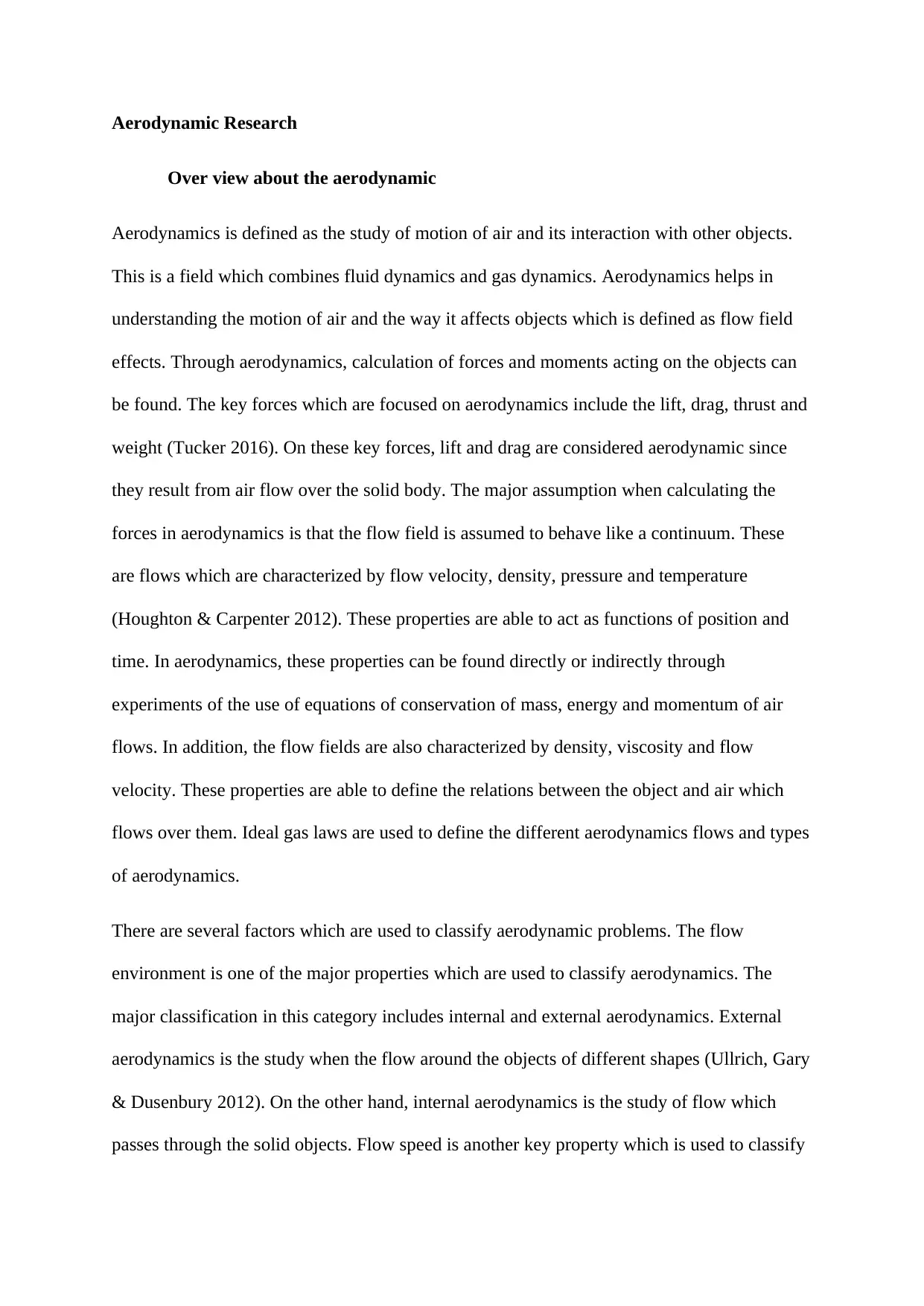
Aerodynamic Research
Over view about the aerodynamic
Aerodynamics is defined as the study of motion of air and its interaction with other objects.
This is a field which combines fluid dynamics and gas dynamics. Aerodynamics helps in
understanding the motion of air and the way it affects objects which is defined as flow field
effects. Through aerodynamics, calculation of forces and moments acting on the objects can
be found. The key forces which are focused on aerodynamics include the lift, drag, thrust and
weight (Tucker 2016). On these key forces, lift and drag are considered aerodynamic since
they result from air flow over the solid body. The major assumption when calculating the
forces in aerodynamics is that the flow field is assumed to behave like a continuum. These
are flows which are characterized by flow velocity, density, pressure and temperature
(Houghton & Carpenter 2012). These properties are able to act as functions of position and
time. In aerodynamics, these properties can be found directly or indirectly through
experiments of the use of equations of conservation of mass, energy and momentum of air
flows. In addition, the flow fields are also characterized by density, viscosity and flow
velocity. These properties are able to define the relations between the object and air which
flows over them. Ideal gas laws are used to define the different aerodynamics flows and types
of aerodynamics.
There are several factors which are used to classify aerodynamic problems. The flow
environment is one of the major properties which are used to classify aerodynamics. The
major classification in this category includes internal and external aerodynamics. External
aerodynamics is the study when the flow around the objects of different shapes (Ullrich, Gary
& Dusenbury 2012). On the other hand, internal aerodynamics is the study of flow which
passes through the solid objects. Flow speed is another key property which is used to classify
Over view about the aerodynamic
Aerodynamics is defined as the study of motion of air and its interaction with other objects.
This is a field which combines fluid dynamics and gas dynamics. Aerodynamics helps in
understanding the motion of air and the way it affects objects which is defined as flow field
effects. Through aerodynamics, calculation of forces and moments acting on the objects can
be found. The key forces which are focused on aerodynamics include the lift, drag, thrust and
weight (Tucker 2016). On these key forces, lift and drag are considered aerodynamic since
they result from air flow over the solid body. The major assumption when calculating the
forces in aerodynamics is that the flow field is assumed to behave like a continuum. These
are flows which are characterized by flow velocity, density, pressure and temperature
(Houghton & Carpenter 2012). These properties are able to act as functions of position and
time. In aerodynamics, these properties can be found directly or indirectly through
experiments of the use of equations of conservation of mass, energy and momentum of air
flows. In addition, the flow fields are also characterized by density, viscosity and flow
velocity. These properties are able to define the relations between the object and air which
flows over them. Ideal gas laws are used to define the different aerodynamics flows and types
of aerodynamics.
There are several factors which are used to classify aerodynamic problems. The flow
environment is one of the major properties which are used to classify aerodynamics. The
major classification in this category includes internal and external aerodynamics. External
aerodynamics is the study when the flow around the objects of different shapes (Ullrich, Gary
& Dusenbury 2012). On the other hand, internal aerodynamics is the study of flow which
passes through the solid objects. Flow speed is another key property which is used to classify
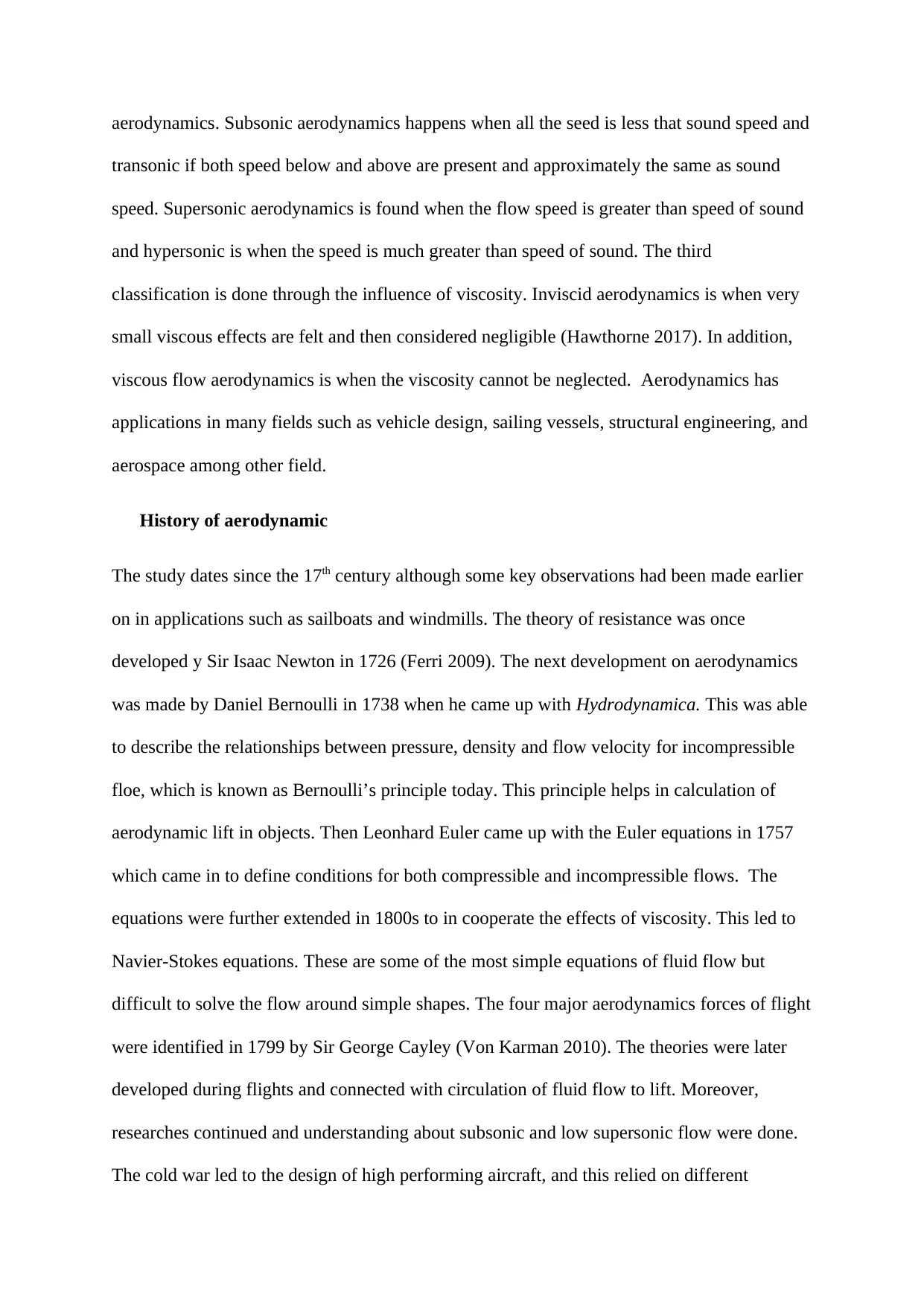
aerodynamics. Subsonic aerodynamics happens when all the seed is less that sound speed and
transonic if both speed below and above are present and approximately the same as sound
speed. Supersonic aerodynamics is found when the flow speed is greater than speed of sound
and hypersonic is when the speed is much greater than speed of sound. The third
classification is done through the influence of viscosity. Inviscid aerodynamics is when very
small viscous effects are felt and then considered negligible (Hawthorne 2017). In addition,
viscous flow aerodynamics is when the viscosity cannot be neglected. Aerodynamics has
applications in many fields such as vehicle design, sailing vessels, structural engineering, and
aerospace among other field.
History of aerodynamic
The study dates since the 17th century although some key observations had been made earlier
on in applications such as sailboats and windmills. The theory of resistance was once
developed y Sir Isaac Newton in 1726 (Ferri 2009). The next development on aerodynamics
was made by Daniel Bernoulli in 1738 when he came up with Hydrodynamica. This was able
to describe the relationships between pressure, density and flow velocity for incompressible
floe, which is known as Bernoulli’s principle today. This principle helps in calculation of
aerodynamic lift in objects. Then Leonhard Euler came up with the Euler equations in 1757
which came in to define conditions for both compressible and incompressible flows. The
equations were further extended in 1800s to in cooperate the effects of viscosity. This led to
Navier-Stokes equations. These are some of the most simple equations of fluid flow but
difficult to solve the flow around simple shapes. The four major aerodynamics forces of flight
were identified in 1799 by Sir George Cayley (Von Karman 2010). The theories were later
developed during flights and connected with circulation of fluid flow to lift. Moreover,
researches continued and understanding about subsonic and low supersonic flow were done.
The cold war led to the design of high performing aircraft, and this relied on different
transonic if both speed below and above are present and approximately the same as sound
speed. Supersonic aerodynamics is found when the flow speed is greater than speed of sound
and hypersonic is when the speed is much greater than speed of sound. The third
classification is done through the influence of viscosity. Inviscid aerodynamics is when very
small viscous effects are felt and then considered negligible (Hawthorne 2017). In addition,
viscous flow aerodynamics is when the viscosity cannot be neglected. Aerodynamics has
applications in many fields such as vehicle design, sailing vessels, structural engineering, and
aerospace among other field.
History of aerodynamic
The study dates since the 17th century although some key observations had been made earlier
on in applications such as sailboats and windmills. The theory of resistance was once
developed y Sir Isaac Newton in 1726 (Ferri 2009). The next development on aerodynamics
was made by Daniel Bernoulli in 1738 when he came up with Hydrodynamica. This was able
to describe the relationships between pressure, density and flow velocity for incompressible
floe, which is known as Bernoulli’s principle today. This principle helps in calculation of
aerodynamic lift in objects. Then Leonhard Euler came up with the Euler equations in 1757
which came in to define conditions for both compressible and incompressible flows. The
equations were further extended in 1800s to in cooperate the effects of viscosity. This led to
Navier-Stokes equations. These are some of the most simple equations of fluid flow but
difficult to solve the flow around simple shapes. The four major aerodynamics forces of flight
were identified in 1799 by Sir George Cayley (Von Karman 2010). The theories were later
developed during flights and connected with circulation of fluid flow to lift. Moreover,
researches continued and understanding about subsonic and low supersonic flow were done.
The cold war led to the design of high performing aircraft, and this relied on different
⊘ This is a preview!⊘
Do you want full access?
Subscribe today to unlock all pages.

Trusted by 1+ million students worldwide
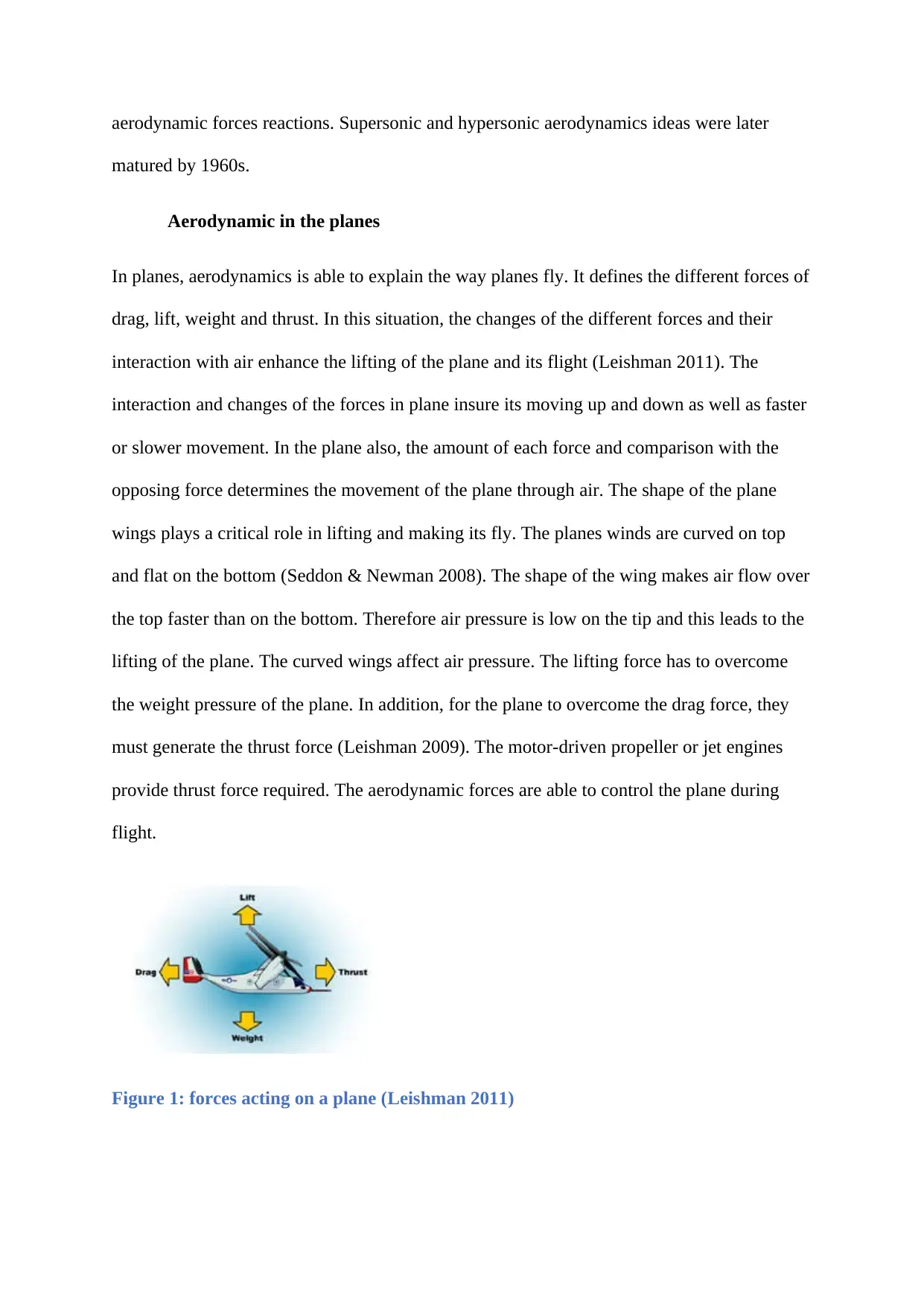
aerodynamic forces reactions. Supersonic and hypersonic aerodynamics ideas were later
matured by 1960s.
Aerodynamic in the planes
In planes, aerodynamics is able to explain the way planes fly. It defines the different forces of
drag, lift, weight and thrust. In this situation, the changes of the different forces and their
interaction with air enhance the lifting of the plane and its flight (Leishman 2011). The
interaction and changes of the forces in plane insure its moving up and down as well as faster
or slower movement. In the plane also, the amount of each force and comparison with the
opposing force determines the movement of the plane through air. The shape of the plane
wings plays a critical role in lifting and making its fly. The planes winds are curved on top
and flat on the bottom (Seddon & Newman 2008). The shape of the wing makes air flow over
the top faster than on the bottom. Therefore air pressure is low on the tip and this leads to the
lifting of the plane. The curved wings affect air pressure. The lifting force has to overcome
the weight pressure of the plane. In addition, for the plane to overcome the drag force, they
must generate the thrust force (Leishman 2009). The motor-driven propeller or jet engines
provide thrust force required. The aerodynamic forces are able to control the plane during
flight.
Figure 1: forces acting on a plane (Leishman 2011)
matured by 1960s.
Aerodynamic in the planes
In planes, aerodynamics is able to explain the way planes fly. It defines the different forces of
drag, lift, weight and thrust. In this situation, the changes of the different forces and their
interaction with air enhance the lifting of the plane and its flight (Leishman 2011). The
interaction and changes of the forces in plane insure its moving up and down as well as faster
or slower movement. In the plane also, the amount of each force and comparison with the
opposing force determines the movement of the plane through air. The shape of the plane
wings plays a critical role in lifting and making its fly. The planes winds are curved on top
and flat on the bottom (Seddon & Newman 2008). The shape of the wing makes air flow over
the top faster than on the bottom. Therefore air pressure is low on the tip and this leads to the
lifting of the plane. The curved wings affect air pressure. The lifting force has to overcome
the weight pressure of the plane. In addition, for the plane to overcome the drag force, they
must generate the thrust force (Leishman 2009). The motor-driven propeller or jet engines
provide thrust force required. The aerodynamic forces are able to control the plane during
flight.
Figure 1: forces acting on a plane (Leishman 2011)
Paraphrase This Document
Need a fresh take? Get an instant paraphrase of this document with our AI Paraphraser
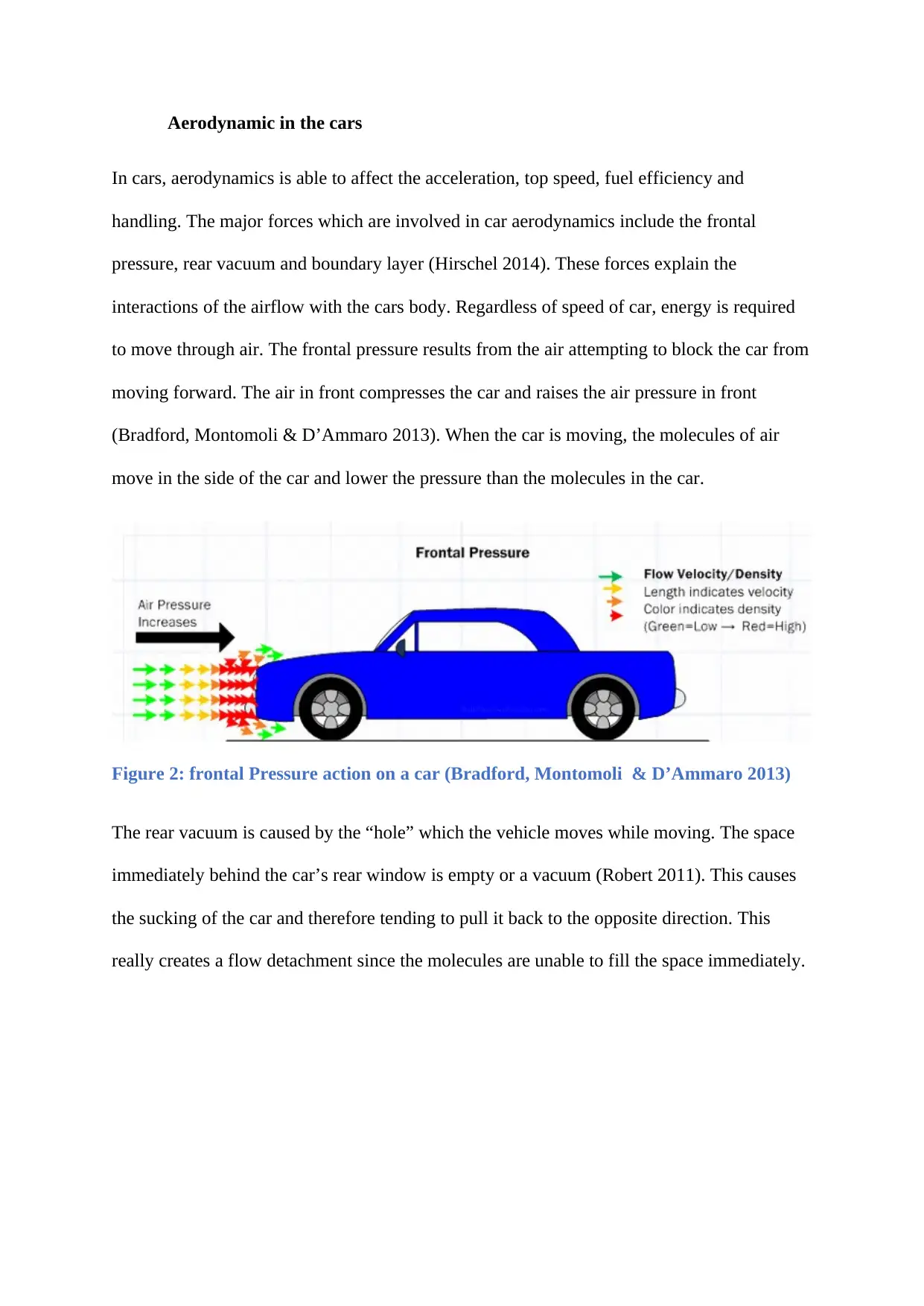
Aerodynamic in the cars
In cars, aerodynamics is able to affect the acceleration, top speed, fuel efficiency and
handling. The major forces which are involved in car aerodynamics include the frontal
pressure, rear vacuum and boundary layer (Hirschel 2014). These forces explain the
interactions of the airflow with the cars body. Regardless of speed of car, energy is required
to move through air. The frontal pressure results from the air attempting to block the car from
moving forward. The air in front compresses the car and raises the air pressure in front
(Bradford, Montomoli & D’Ammaro 2013). When the car is moving, the molecules of air
move in the side of the car and lower the pressure than the molecules in the car.
Figure 2: frontal Pressure action on a car (Bradford, Montomoli & D’Ammaro 2013)
The rear vacuum is caused by the “hole” which the vehicle moves while moving. The space
immediately behind the car’s rear window is empty or a vacuum (Robert 2011). This causes
the sucking of the car and therefore tending to pull it back to the opposite direction. This
really creates a flow detachment since the molecules are unable to fill the space immediately.
In cars, aerodynamics is able to affect the acceleration, top speed, fuel efficiency and
handling. The major forces which are involved in car aerodynamics include the frontal
pressure, rear vacuum and boundary layer (Hirschel 2014). These forces explain the
interactions of the airflow with the cars body. Regardless of speed of car, energy is required
to move through air. The frontal pressure results from the air attempting to block the car from
moving forward. The air in front compresses the car and raises the air pressure in front
(Bradford, Montomoli & D’Ammaro 2013). When the car is moving, the molecules of air
move in the side of the car and lower the pressure than the molecules in the car.
Figure 2: frontal Pressure action on a car (Bradford, Montomoli & D’Ammaro 2013)
The rear vacuum is caused by the “hole” which the vehicle moves while moving. The space
immediately behind the car’s rear window is empty or a vacuum (Robert 2011). This causes
the sucking of the car and therefore tending to pull it back to the opposite direction. This
really creates a flow detachment since the molecules are unable to fill the space immediately.
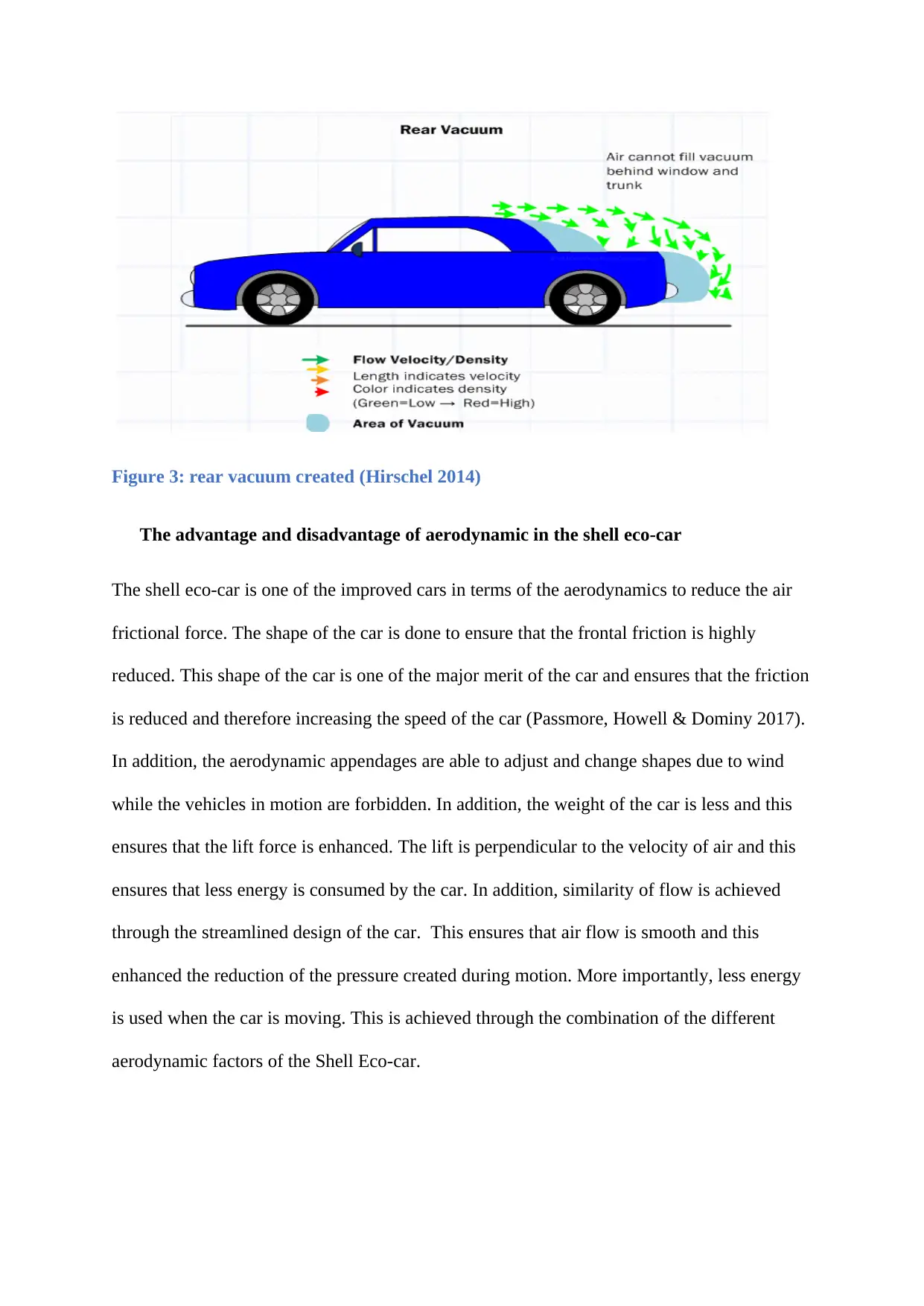
Figure 3: rear vacuum created (Hirschel 2014)
The advantage and disadvantage of aerodynamic in the shell eco-car
The shell eco-car is one of the improved cars in terms of the aerodynamics to reduce the air
frictional force. The shape of the car is done to ensure that the frontal friction is highly
reduced. This shape of the car is one of the major merit of the car and ensures that the friction
is reduced and therefore increasing the speed of the car (Passmore, Howell & Dominy 2017).
In addition, the aerodynamic appendages are able to adjust and change shapes due to wind
while the vehicles in motion are forbidden. In addition, the weight of the car is less and this
ensures that the lift force is enhanced. The lift is perpendicular to the velocity of air and this
ensures that less energy is consumed by the car. In addition, similarity of flow is achieved
through the streamlined design of the car. This ensures that air flow is smooth and this
enhanced the reduction of the pressure created during motion. More importantly, less energy
is used when the car is moving. This is achieved through the combination of the different
aerodynamic factors of the Shell Eco-car.
The advantage and disadvantage of aerodynamic in the shell eco-car
The shell eco-car is one of the improved cars in terms of the aerodynamics to reduce the air
frictional force. The shape of the car is done to ensure that the frontal friction is highly
reduced. This shape of the car is one of the major merit of the car and ensures that the friction
is reduced and therefore increasing the speed of the car (Passmore, Howell & Dominy 2017).
In addition, the aerodynamic appendages are able to adjust and change shapes due to wind
while the vehicles in motion are forbidden. In addition, the weight of the car is less and this
ensures that the lift force is enhanced. The lift is perpendicular to the velocity of air and this
ensures that less energy is consumed by the car. In addition, similarity of flow is achieved
through the streamlined design of the car. This ensures that air flow is smooth and this
enhanced the reduction of the pressure created during motion. More importantly, less energy
is used when the car is moving. This is achieved through the combination of the different
aerodynamic factors of the Shell Eco-car.
⊘ This is a preview!⊘
Do you want full access?
Subscribe today to unlock all pages.

Trusted by 1+ million students worldwide
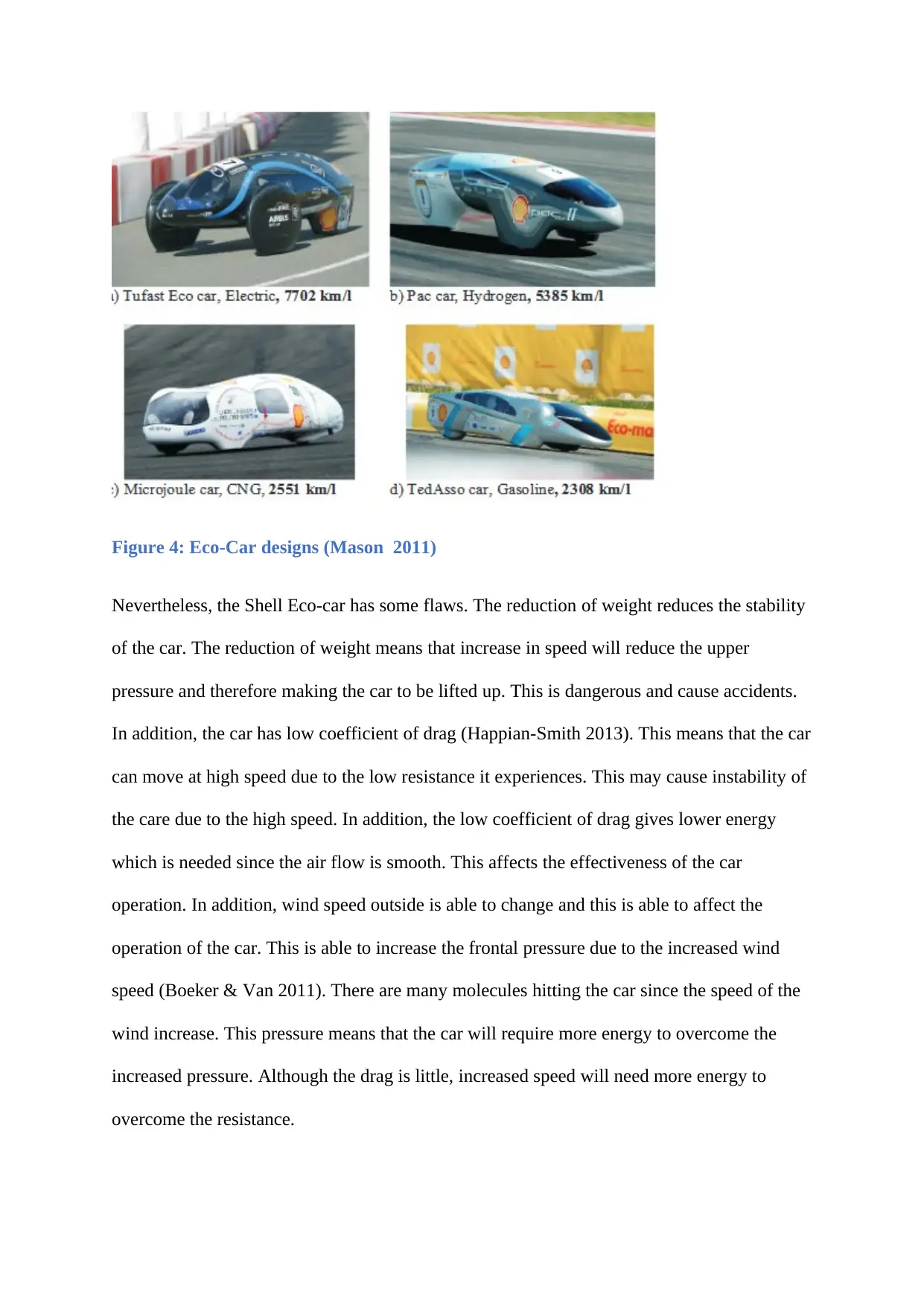
Figure 4: Eco-Car designs (Mason 2011)
Nevertheless, the Shell Eco-car has some flaws. The reduction of weight reduces the stability
of the car. The reduction of weight means that increase in speed will reduce the upper
pressure and therefore making the car to be lifted up. This is dangerous and cause accidents.
In addition, the car has low coefficient of drag (Happian-Smith 2013). This means that the car
can move at high speed due to the low resistance it experiences. This may cause instability of
the care due to the high speed. In addition, the low coefficient of drag gives lower energy
which is needed since the air flow is smooth. This affects the effectiveness of the car
operation. In addition, wind speed outside is able to change and this is able to affect the
operation of the car. This is able to increase the frontal pressure due to the increased wind
speed (Boeker & Van 2011). There are many molecules hitting the car since the speed of the
wind increase. This pressure means that the car will require more energy to overcome the
increased pressure. Although the drag is little, increased speed will need more energy to
overcome the resistance.
Nevertheless, the Shell Eco-car has some flaws. The reduction of weight reduces the stability
of the car. The reduction of weight means that increase in speed will reduce the upper
pressure and therefore making the car to be lifted up. This is dangerous and cause accidents.
In addition, the car has low coefficient of drag (Happian-Smith 2013). This means that the car
can move at high speed due to the low resistance it experiences. This may cause instability of
the care due to the high speed. In addition, the low coefficient of drag gives lower energy
which is needed since the air flow is smooth. This affects the effectiveness of the car
operation. In addition, wind speed outside is able to change and this is able to affect the
operation of the car. This is able to increase the frontal pressure due to the increased wind
speed (Boeker & Van 2011). There are many molecules hitting the car since the speed of the
wind increase. This pressure means that the car will require more energy to overcome the
increased pressure. Although the drag is little, increased speed will need more energy to
overcome the resistance.
Paraphrase This Document
Need a fresh take? Get an instant paraphrase of this document with our AI Paraphraser
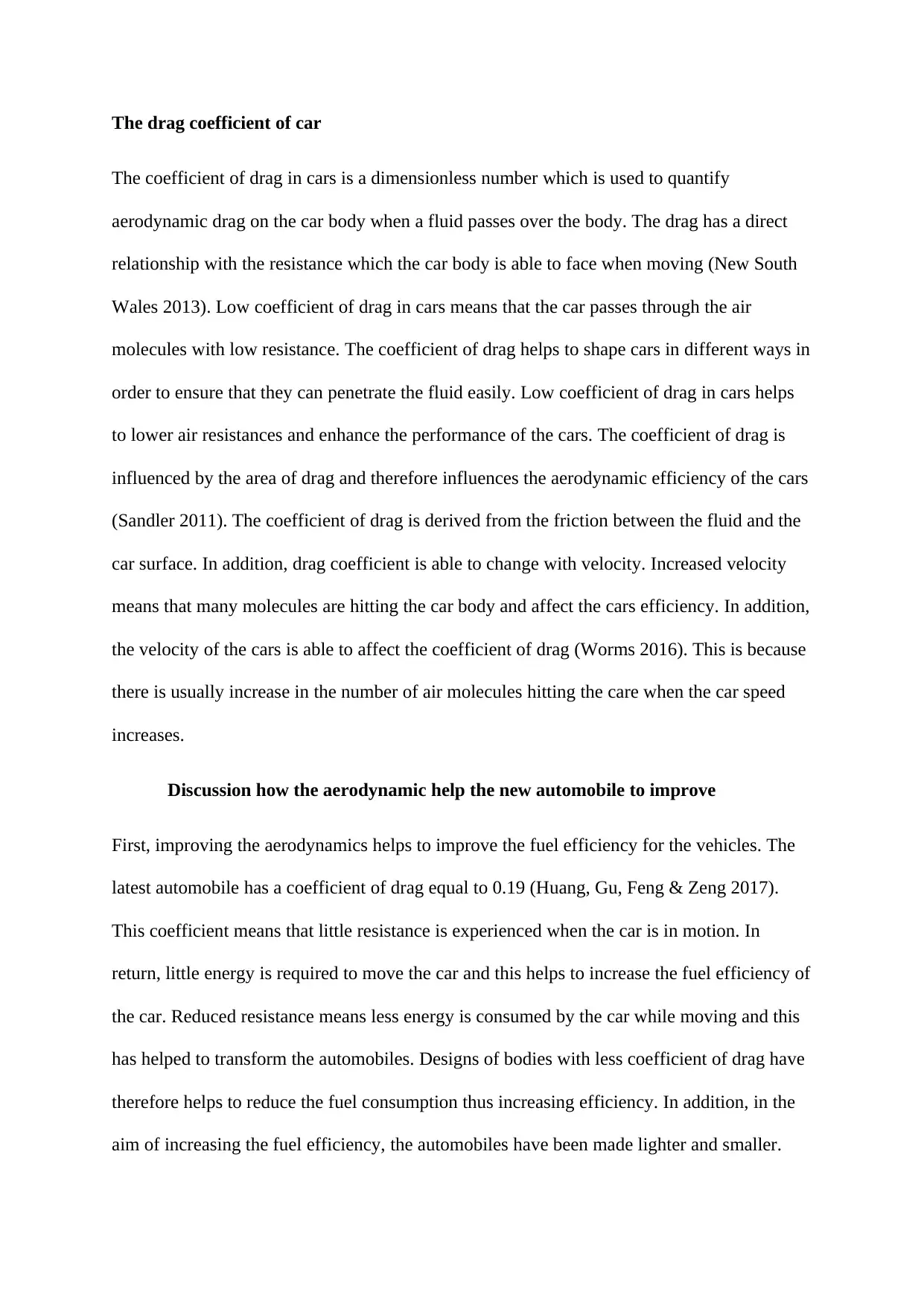
The drag coefficient of car
The coefficient of drag in cars is a dimensionless number which is used to quantify
aerodynamic drag on the car body when a fluid passes over the body. The drag has a direct
relationship with the resistance which the car body is able to face when moving (New South
Wales 2013). Low coefficient of drag in cars means that the car passes through the air
molecules with low resistance. The coefficient of drag helps to shape cars in different ways in
order to ensure that they can penetrate the fluid easily. Low coefficient of drag in cars helps
to lower air resistances and enhance the performance of the cars. The coefficient of drag is
influenced by the area of drag and therefore influences the aerodynamic efficiency of the cars
(Sandler 2011). The coefficient of drag is derived from the friction between the fluid and the
car surface. In addition, drag coefficient is able to change with velocity. Increased velocity
means that many molecules are hitting the car body and affect the cars efficiency. In addition,
the velocity of the cars is able to affect the coefficient of drag (Worms 2016). This is because
there is usually increase in the number of air molecules hitting the care when the car speed
increases.
Discussion how the aerodynamic help the new automobile to improve
First, improving the aerodynamics helps to improve the fuel efficiency for the vehicles. The
latest automobile has a coefficient of drag equal to 0.19 (Huang, Gu, Feng & Zeng 2017).
This coefficient means that little resistance is experienced when the car is in motion. In
return, little energy is required to move the car and this helps to increase the fuel efficiency of
the car. Reduced resistance means less energy is consumed by the car while moving and this
has helped to transform the automobiles. Designs of bodies with less coefficient of drag have
therefore helps to reduce the fuel consumption thus increasing efficiency. In addition, in the
aim of increasing the fuel efficiency, the automobiles have been made lighter and smaller.
The coefficient of drag in cars is a dimensionless number which is used to quantify
aerodynamic drag on the car body when a fluid passes over the body. The drag has a direct
relationship with the resistance which the car body is able to face when moving (New South
Wales 2013). Low coefficient of drag in cars means that the car passes through the air
molecules with low resistance. The coefficient of drag helps to shape cars in different ways in
order to ensure that they can penetrate the fluid easily. Low coefficient of drag in cars helps
to lower air resistances and enhance the performance of the cars. The coefficient of drag is
influenced by the area of drag and therefore influences the aerodynamic efficiency of the cars
(Sandler 2011). The coefficient of drag is derived from the friction between the fluid and the
car surface. In addition, drag coefficient is able to change with velocity. Increased velocity
means that many molecules are hitting the car body and affect the cars efficiency. In addition,
the velocity of the cars is able to affect the coefficient of drag (Worms 2016). This is because
there is usually increase in the number of air molecules hitting the care when the car speed
increases.
Discussion how the aerodynamic help the new automobile to improve
First, improving the aerodynamics helps to improve the fuel efficiency for the vehicles. The
latest automobile has a coefficient of drag equal to 0.19 (Huang, Gu, Feng & Zeng 2017).
This coefficient means that little resistance is experienced when the car is in motion. In
return, little energy is required to move the car and this helps to increase the fuel efficiency of
the car. Reduced resistance means less energy is consumed by the car while moving and this
has helped to transform the automobiles. Designs of bodies with less coefficient of drag have
therefore helps to reduce the fuel consumption thus increasing efficiency. In addition, in the
aim of increasing the fuel efficiency, the automobiles have been made lighter and smaller.
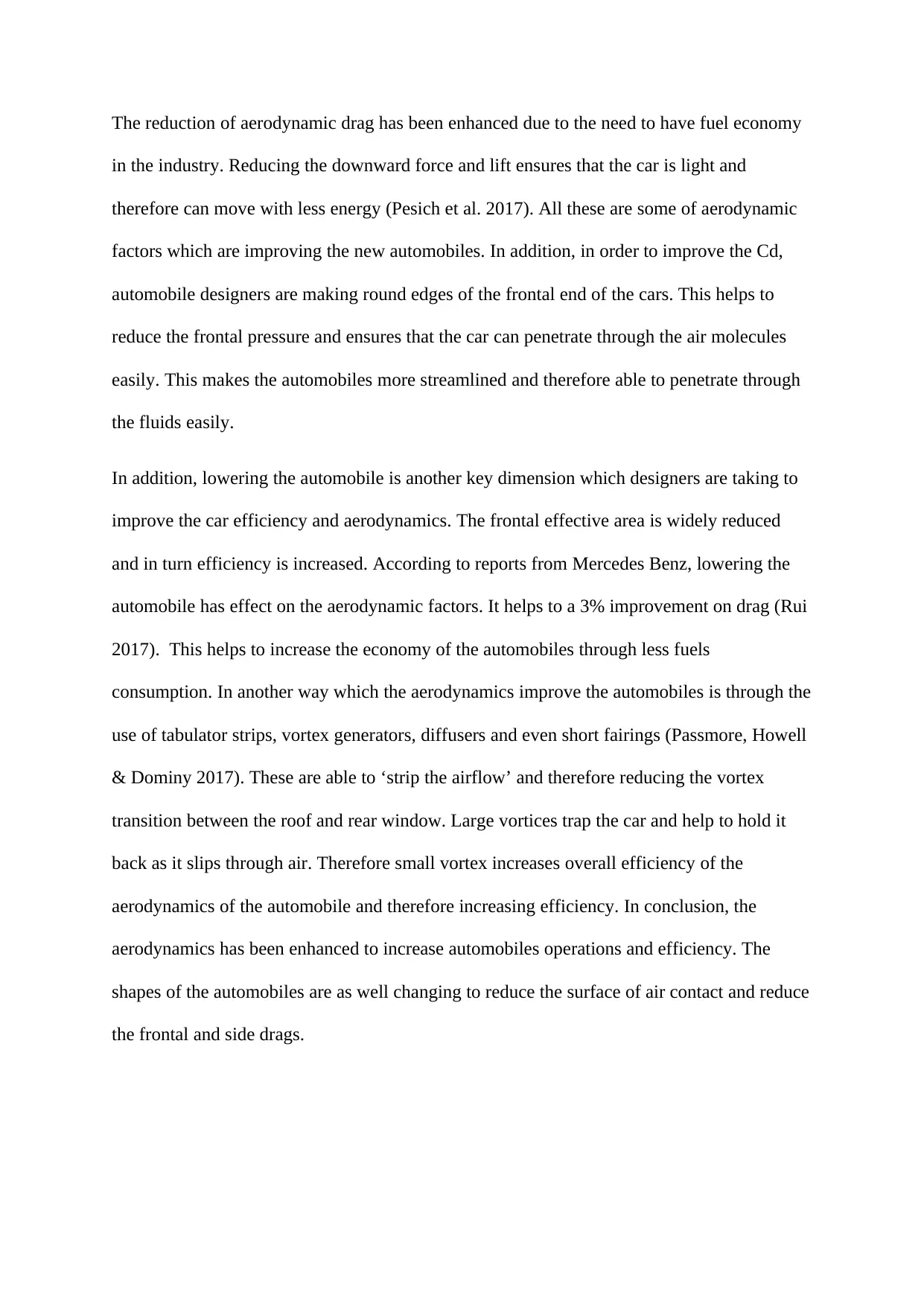
The reduction of aerodynamic drag has been enhanced due to the need to have fuel economy
in the industry. Reducing the downward force and lift ensures that the car is light and
therefore can move with less energy (Pesich et al. 2017). All these are some of aerodynamic
factors which are improving the new automobiles. In addition, in order to improve the Cd,
automobile designers are making round edges of the frontal end of the cars. This helps to
reduce the frontal pressure and ensures that the car can penetrate through the air molecules
easily. This makes the automobiles more streamlined and therefore able to penetrate through
the fluids easily.
In addition, lowering the automobile is another key dimension which designers are taking to
improve the car efficiency and aerodynamics. The frontal effective area is widely reduced
and in turn efficiency is increased. According to reports from Mercedes Benz, lowering the
automobile has effect on the aerodynamic factors. It helps to a 3% improvement on drag (Rui
2017). This helps to increase the economy of the automobiles through less fuels
consumption. In another way which the aerodynamics improve the automobiles is through the
use of tabulator strips, vortex generators, diffusers and even short fairings (Passmore, Howell
& Dominy 2017). These are able to ‘strip the airflow’ and therefore reducing the vortex
transition between the roof and rear window. Large vortices trap the car and help to hold it
back as it slips through air. Therefore small vortex increases overall efficiency of the
aerodynamics of the automobile and therefore increasing efficiency. In conclusion, the
aerodynamics has been enhanced to increase automobiles operations and efficiency. The
shapes of the automobiles are as well changing to reduce the surface of air contact and reduce
the frontal and side drags.
in the industry. Reducing the downward force and lift ensures that the car is light and
therefore can move with less energy (Pesich et al. 2017). All these are some of aerodynamic
factors which are improving the new automobiles. In addition, in order to improve the Cd,
automobile designers are making round edges of the frontal end of the cars. This helps to
reduce the frontal pressure and ensures that the car can penetrate through the air molecules
easily. This makes the automobiles more streamlined and therefore able to penetrate through
the fluids easily.
In addition, lowering the automobile is another key dimension which designers are taking to
improve the car efficiency and aerodynamics. The frontal effective area is widely reduced
and in turn efficiency is increased. According to reports from Mercedes Benz, lowering the
automobile has effect on the aerodynamic factors. It helps to a 3% improvement on drag (Rui
2017). This helps to increase the economy of the automobiles through less fuels
consumption. In another way which the aerodynamics improve the automobiles is through the
use of tabulator strips, vortex generators, diffusers and even short fairings (Passmore, Howell
& Dominy 2017). These are able to ‘strip the airflow’ and therefore reducing the vortex
transition between the roof and rear window. Large vortices trap the car and help to hold it
back as it slips through air. Therefore small vortex increases overall efficiency of the
aerodynamics of the automobile and therefore increasing efficiency. In conclusion, the
aerodynamics has been enhanced to increase automobiles operations and efficiency. The
shapes of the automobiles are as well changing to reduce the surface of air contact and reduce
the frontal and side drags.
⊘ This is a preview!⊘
Do you want full access?
Subscribe today to unlock all pages.

Trusted by 1+ million students worldwide
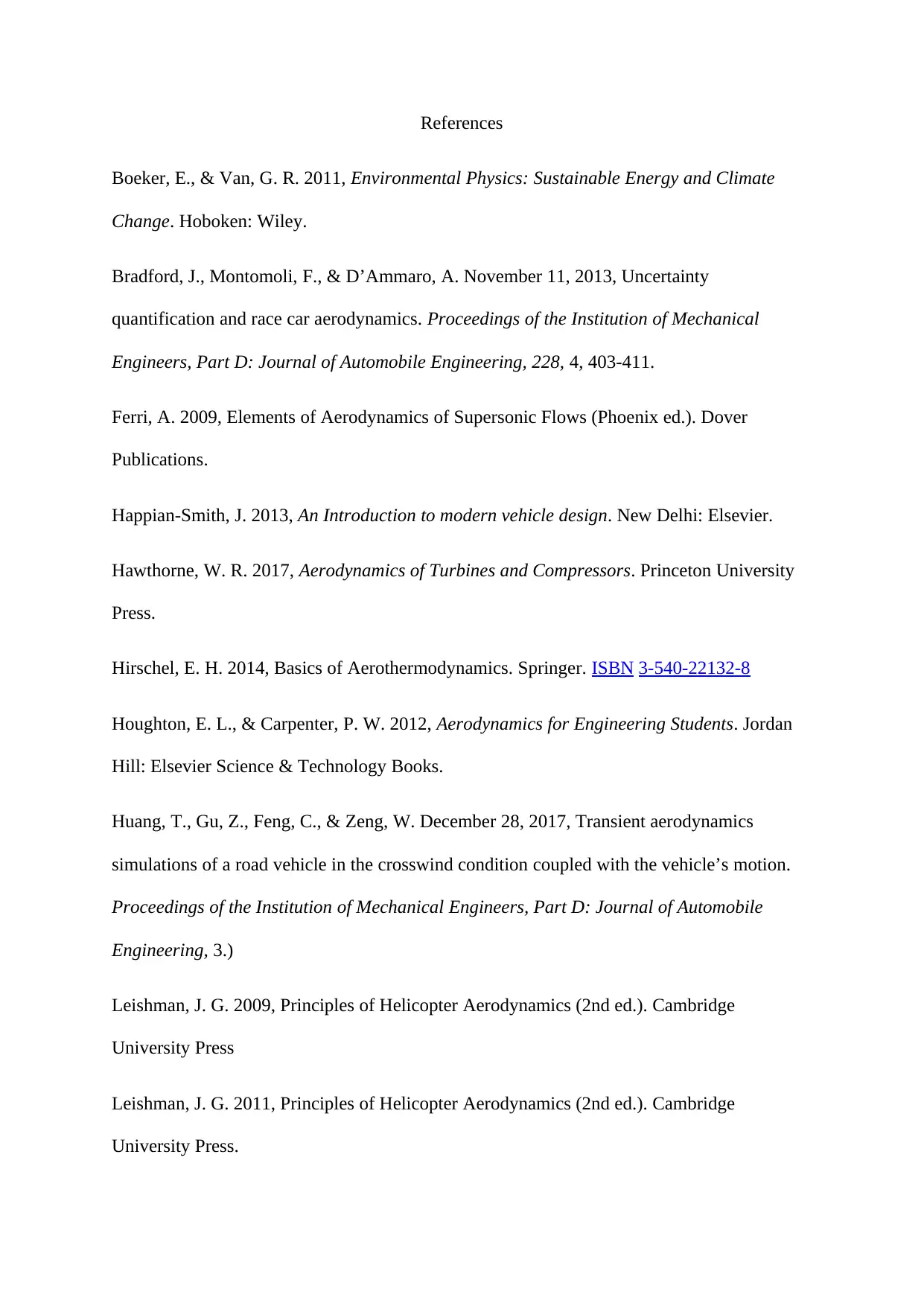
References
Boeker, E., & Van, G. R. 2011, Environmental Physics: Sustainable Energy and Climate
Change. Hoboken: Wiley.
Bradford, J., Montomoli, F., & D’Ammaro, A. November 11, 2013, Uncertainty
quantification and race car aerodynamics. Proceedings of the Institution of Mechanical
Engineers, Part D: Journal of Automobile Engineering, 228, 4, 403-411.
Ferri, A. 2009, Elements of Aerodynamics of Supersonic Flows (Phoenix ed.). Dover
Publications.
Happian-Smith, J. 2013, An Introduction to modern vehicle design. New Delhi: Elsevier.
Hawthorne, W. R. 2017, Aerodynamics of Turbines and Compressors. Princeton University
Press.
Hirschel, E. H. 2014, Basics of Aerothermodynamics. Springer. ISBN 3-540-22132-8
Houghton, E. L., & Carpenter, P. W. 2012, Aerodynamics for Engineering Students. Jordan
Hill: Elsevier Science & Technology Books.
Huang, T., Gu, Z., Feng, C., & Zeng, W. December 28, 2017, Transient aerodynamics
simulations of a road vehicle in the crosswind condition coupled with the vehicle’s motion.
Proceedings of the Institution of Mechanical Engineers, Part D: Journal of Automobile
Engineering, 3.)
Leishman, J. G. 2009, Principles of Helicopter Aerodynamics (2nd ed.). Cambridge
University Press
Leishman, J. G. 2011, Principles of Helicopter Aerodynamics (2nd ed.). Cambridge
University Press.
Boeker, E., & Van, G. R. 2011, Environmental Physics: Sustainable Energy and Climate
Change. Hoboken: Wiley.
Bradford, J., Montomoli, F., & D’Ammaro, A. November 11, 2013, Uncertainty
quantification and race car aerodynamics. Proceedings of the Institution of Mechanical
Engineers, Part D: Journal of Automobile Engineering, 228, 4, 403-411.
Ferri, A. 2009, Elements of Aerodynamics of Supersonic Flows (Phoenix ed.). Dover
Publications.
Happian-Smith, J. 2013, An Introduction to modern vehicle design. New Delhi: Elsevier.
Hawthorne, W. R. 2017, Aerodynamics of Turbines and Compressors. Princeton University
Press.
Hirschel, E. H. 2014, Basics of Aerothermodynamics. Springer. ISBN 3-540-22132-8
Houghton, E. L., & Carpenter, P. W. 2012, Aerodynamics for Engineering Students. Jordan
Hill: Elsevier Science & Technology Books.
Huang, T., Gu, Z., Feng, C., & Zeng, W. December 28, 2017, Transient aerodynamics
simulations of a road vehicle in the crosswind condition coupled with the vehicle’s motion.
Proceedings of the Institution of Mechanical Engineers, Part D: Journal of Automobile
Engineering, 3.)
Leishman, J. G. 2009, Principles of Helicopter Aerodynamics (2nd ed.). Cambridge
University Press
Leishman, J. G. 2011, Principles of Helicopter Aerodynamics (2nd ed.). Cambridge
University Press.
Paraphrase This Document
Need a fresh take? Get an instant paraphrase of this document with our AI Paraphraser
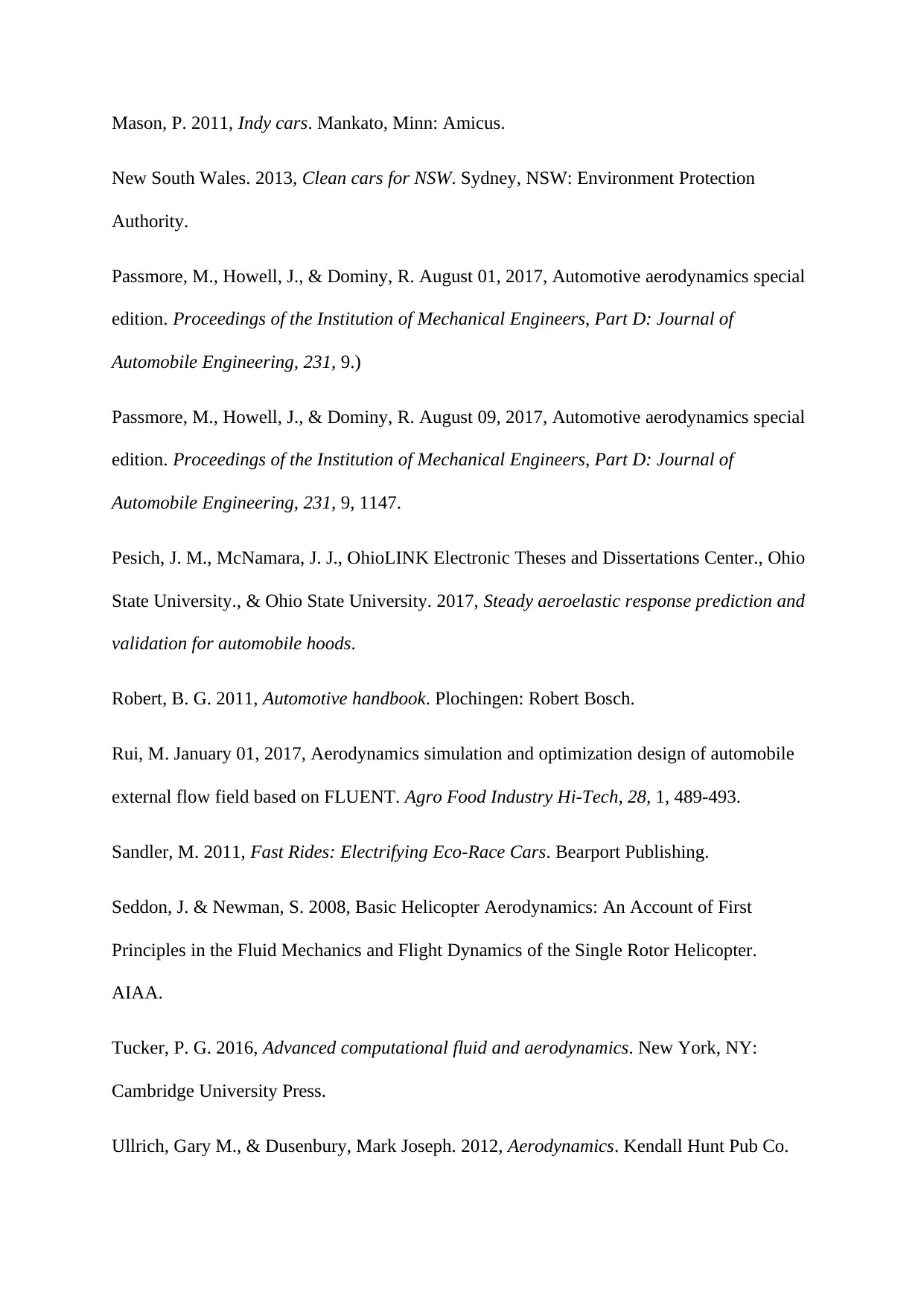
Mason, P. 2011, Indy cars. Mankato, Minn: Amicus.
New South Wales. 2013, Clean cars for NSW. Sydney, NSW: Environment Protection
Authority.
Passmore, M., Howell, J., & Dominy, R. August 01, 2017, Automotive aerodynamics special
edition. Proceedings of the Institution of Mechanical Engineers, Part D: Journal of
Automobile Engineering, 231, 9.)
Passmore, M., Howell, J., & Dominy, R. August 09, 2017, Automotive aerodynamics special
edition. Proceedings of the Institution of Mechanical Engineers, Part D: Journal of
Automobile Engineering, 231, 9, 1147.
Pesich, J. M., McNamara, J. J., OhioLINK Electronic Theses and Dissertations Center., Ohio
State University., & Ohio State University. 2017, Steady aeroelastic response prediction and
validation for automobile hoods.
Robert, B. G. 2011, Automotive handbook. Plochingen: Robert Bosch.
Rui, M. January 01, 2017, Aerodynamics simulation and optimization design of automobile
external flow field based on FLUENT. Agro Food Industry Hi-Tech, 28, 1, 489-493.
Sandler, M. 2011, Fast Rides: Electrifying Eco-Race Cars. Bearport Publishing.
Seddon, J. & Newman, S. 2008, Basic Helicopter Aerodynamics: An Account of First
Principles in the Fluid Mechanics and Flight Dynamics of the Single Rotor Helicopter.
AIAA.
Tucker, P. G. 2016, Advanced computational fluid and aerodynamics. New York, NY:
Cambridge University Press.
Ullrich, Gary M., & Dusenbury, Mark Joseph. 2012, Aerodynamics. Kendall Hunt Pub Co.
New South Wales. 2013, Clean cars for NSW. Sydney, NSW: Environment Protection
Authority.
Passmore, M., Howell, J., & Dominy, R. August 01, 2017, Automotive aerodynamics special
edition. Proceedings of the Institution of Mechanical Engineers, Part D: Journal of
Automobile Engineering, 231, 9.)
Passmore, M., Howell, J., & Dominy, R. August 09, 2017, Automotive aerodynamics special
edition. Proceedings of the Institution of Mechanical Engineers, Part D: Journal of
Automobile Engineering, 231, 9, 1147.
Pesich, J. M., McNamara, J. J., OhioLINK Electronic Theses and Dissertations Center., Ohio
State University., & Ohio State University. 2017, Steady aeroelastic response prediction and
validation for automobile hoods.
Robert, B. G. 2011, Automotive handbook. Plochingen: Robert Bosch.
Rui, M. January 01, 2017, Aerodynamics simulation and optimization design of automobile
external flow field based on FLUENT. Agro Food Industry Hi-Tech, 28, 1, 489-493.
Sandler, M. 2011, Fast Rides: Electrifying Eco-Race Cars. Bearport Publishing.
Seddon, J. & Newman, S. 2008, Basic Helicopter Aerodynamics: An Account of First
Principles in the Fluid Mechanics and Flight Dynamics of the Single Rotor Helicopter.
AIAA.
Tucker, P. G. 2016, Advanced computational fluid and aerodynamics. New York, NY:
Cambridge University Press.
Ullrich, Gary M., & Dusenbury, Mark Joseph. 2012, Aerodynamics. Kendall Hunt Pub Co.

Von Karman, T. 2010, Aerodynamics: Selected Topics in the Light of Their Historical
Development. Dover Publications.
Worms, P. 2016, Eco cars. Mankato, Minnesota: Smart Apple media.
Development. Dover Publications.
Worms, P. 2016, Eco cars. Mankato, Minnesota: Smart Apple media.
⊘ This is a preview!⊘
Do you want full access?
Subscribe today to unlock all pages.

Trusted by 1+ million students worldwide
1 out of 12
Related Documents
Your All-in-One AI-Powered Toolkit for Academic Success.
+13062052269
info@desklib.com
Available 24*7 on WhatsApp / Email
![[object Object]](/_next/static/media/star-bottom.7253800d.svg)
Unlock your academic potential
Copyright © 2020–2025 A2Z Services. All Rights Reserved. Developed and managed by ZUCOL.





